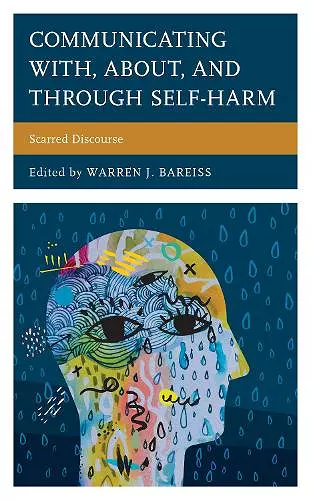Communicating With, About, and Through Self-Harm
Scarred Discourse
Format:Paperback
Publisher:Bloomsbury Publishing PLC
Published:18th Aug '22
Currently unavailable, and unfortunately no date known when it will be back
This paperback is available in another edition too:
- Hardback£90.00(9781498563055)

Non-suicidal self-injury (NSSI) is the deliberate harming of one's body without suicidal intent. NSSI tends to be secretive, often involving cutting, bruising, or burning on hidden parts of the body. While NSSI often occurs among adolescents, it is not limited to that age group. Communication and NSSI intersect in many ways, including conversation among family members, consultation with healthcare providers, representation in the media, discourse among people who self-injure, and even communication with oneself. Each chapter in Communicating With, About, and Through Self-Harm: Scarred Discourse addresses a different context of communication crucial to our understanding NSSI. An international group of clinicians and communication specialists describe, analyze, and explain how NSSI is communicated about, what NSSI is communicating, and how can we do a better job in communicating with others about NSSI. This book’s fundamental purpose is to empower individuals who self-injure as well as their families, friends, healthcare providers, and communities to better understand and deal with NSSI and the pressures that cause it.
Bareiss envelops the complexities of a certain class of human behaviors in this thoughtfully curated volume. Each chapter serves as a gateway to comprehending the multifaceted experience of persons affected by non-suicidal self-injury (NSSI) and its communicative channels. To unravel the entanglement of functions involved, Bareiss invited a panel of diverse scholars and clinicians to provide insights. The essays that compose the volume are contextually practical while expressing a respectful tone, carefully maintained across the different voices of the various contributors. Bareiss acknowledges that "this book's fundamental purpose is to empower individuals," and with this singular goal each chapter provides a unique path to awareness and compassion for those who may be seeking help with unconventional communicative behaviors. Recommended. * Choice Reviews *
Is self-injury a form of communication? What message, if any, can be communicated through the act? Tackling these intricate questions, this impressive volume reveals how the experience of self-injury is communicated via scars, journals, media and clinical discourse, wherein the wounded bodies become the nexus of meaning, relationship, and control. Lively and sophisticated, this is a must read for those interested in communicative dimensions of self-injury. -- Yukari Seko, Ryerson University
This collection is informative and insightful. The contributors set out to place the contemporary phenomenon of self-injury into a number of contexts that foreground the communicative and deeply complex social aspects of the behaviour. The collection adds considerable value to the seam of socially-oriented professional studies, looking at online forums, diaries, news media, and even fictional portrayals of self-harm. It is a compassionate and reflexive set of contributions, expertly marshalled and bookended by Warren Bareiss; the book seeks to foreground communicative aspects without slipping into reactionary tropes about 'attention-seeking'. It carries throughout the firm conviction that self-injurious behaviour is usefully understood as human communication, enacted and received in particular contexts, and not simply as a blanket term for something pathological. -- Dr. Chris Millard, University of Sheffield
We have come along way in the last decade in understanding self injury from the vantage point of science. What we have lacked, until now, is a robust, refined, and compassionate-laced understanding of what self-injury communicates to and for individuals who use it and to and for those who bear witness—from near and afar. This edited volume offers important, unique and, ultimately, humane insight into the ways in which how we speak about self-injury matters and why it is so important to deeply listen to what we hear. -- Janis L. Whitlock, Cornell University
This text brings together expert, innovative content to highlight a diverse array of topics related to the communicative aspects of self-injury and the importance of understanding NSSI within a relational context. The creative and timely knowledge shared in this text expands current understandings of self-injury, adding depth to professionals’ conceptualization of this behavior. It’s a refreshing addition to the literature in this area. -- Jennifer L. Muehlenkamp, University of Wisconsin Eau Claire
ISBN: 9781498563079
Dimensions: 228mm x 152mm x 17mm
Weight: 336g
242 pages